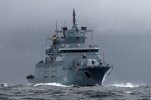USS White Plains (CVE-66). One of the 50 (not a typo)
Casablanca class escort carriers produced between 1943 and 1944, it was one on the escort carriers in Taffy-3, under assault by Admiral Kurita's surface force at Leyte Gulf. The massive battleship
Yamato opened fired at 34,000+ yards, straddling the carrier. The near misses caused minor damage but massive amounts of black smoke, resulting in the
Yamato thinking the carrier was hit and shifting fire.
As the escort carriers fled south with the Japanese surface force in pursuit, the range closed enough whereby the
White Plains lone 5"/38 cal gun began firing on the approaching Japanese cruisers. Evidence suggests that one lucky shot hit the heavy cruiser
Chokai amidship - directly on the the launcher for its huge Long Lance torpedoes. The 8 torpedoes exploded, taking out the rudder and engines of the 15,800 ton heavy cruiser and leaving it easy prey for aircraft.
Length: 512 ft, Beam: 65 ft (hull), 108 ft (flight deck), Displacement: 10,400 tons, 9,000 HP gave 20 knots
Armament: 1 5"/38 cal cannon, 16 (8x2) 40mm Bofors, 20 20mm Oerkilons, 28 aircraft.
Commissioned: 1943, Decommissioned: 1946, Struck: 1958
White Plains attack by Tokkotai unit 25 October 1944. The aircraft in the photograph missed the carrier and struck the water.
File:USS White Plains (CVE-66) during Battle of Samar 1944.
Chōkai at anchor in the Chuuk Islands, November 20, 1942. Battleship
Yamato can be seen in the left background.
































